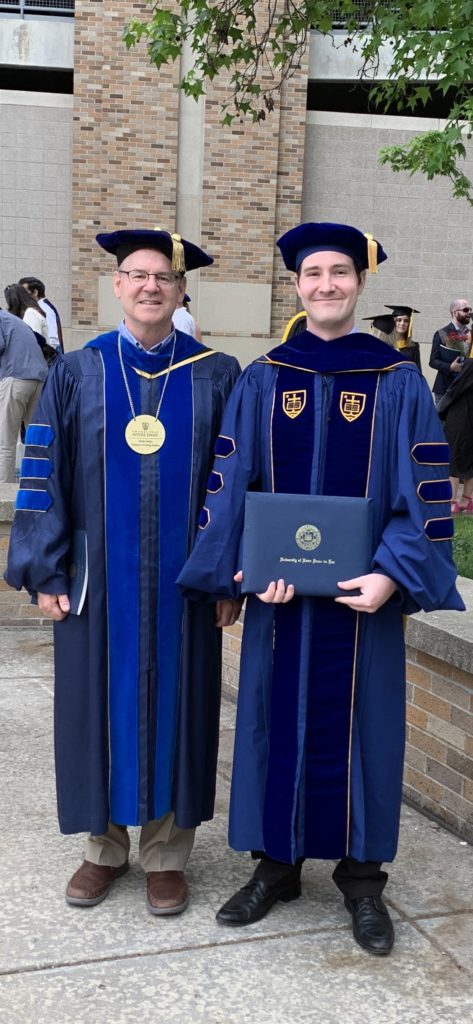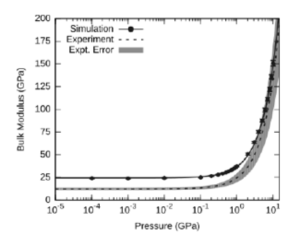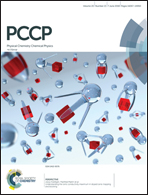Congratulations to Garrett Tow, who successfully defended his thesis and graduated with his PhD this May. Garrett plans to take a computational research position with the Army Research Lab this summer. Well done!

University of Notre Dame
Congratulations to Garrett Tow, who successfully defended his thesis and graduated with his PhD this May. Garrett plans to take a computational research position with the Army Research Lab this summer. Well done!

Ryan DeFever, as part of the NSF-funded MoSDeF team, has developed a complete Python interface to Cassandra that enables rapid setup of Cassandra simulations. The tools help build the systems, assign atom types and force field parameters, and launch the job. The result is more reproducible results that are well documented and reliable. You can check out the tools at https://github.com/MaginnGroup/mosdef_cassandra
A paper describing the tools was published in the Journal of Computational Chemistry https://onlinelibrary.wiley.com/doi/10.1002/jcc.26544

Working with the BEES team at Case Western, Derrick Poe co-authored a recent paper entitled “A Nitroxide Containing Organic Molecule in a Deep Eutectic Solvent for Flow Battery Applications” (Journal of the Electrochemical Society, 2021, 168, 020527, https://doi.org/10.1149/1945-7111/abe28a). In this work, experimental and computational studies were carried out to investigate the nitroxide radical redox organic molecule, 2-phenyl-4,4,5,5-tetrame-thylimidazoline-1-oxyl-3-oxide (PTIO) in a deep eutectic solvent consisting of 1 1:4 molar mixture of choline chloride and ethylene glycol. Molecular modeling was performed to investigate the relative stability of PTIO as compared to the previously studied 4-hydroxy-TEMPO (4HT). It was found that the oxoammonium cation 4HT+ exhibits a noticeably larger nucleophilic reactive cloud as compared to PTIO+, indicating a higher reactivity.
Happy to announce that a Perspective paper was just published in the AIChE Journal entitled “Open‐source molecular modeling software in chemical engineering focusing on the Molecular Simulation Design Framework”. This paper describes work the MoSDeF team did in developing methods to improve the reliability and accuracy of molecular simulation software. Congratulations to Ryan DeFever, who played a huge role in this work!
Three new graduate students joined the group this year. Ning Wang (B.S. Polymer Materials and Engineering, Beijing University of Chemical Technology, M.S. Materials Science and Engineering, University of Pennsylvania), Fernando Carmoda (B.S. Chemical Engineering, University of Puerto Rico at Mayaguez), and Dinis Abranches (BSc and MSc in Chemical Engineering, University of Aveiro, Portugal). Welcome!
A recent paper from our group, in collaboration with Luciano Costa’s group at Fluminense Federal University (Brazil) and Burcu Gurkan’s group at Case Western Reserve University, has been featured by the Joint Center for Energy Storage Research (JCESR).
In this paper, our team used Raman spectroscopy and molecular dynamics (MD) simulations to study the structural and dynamical changes in the solvation shell surrounding Li+ in a ternary electrolyte is composed of a mixture of two ionic liquids (ILs), n-methyl-n-propylpyrrolidinium bis(trifluoromethanesulfonyl)imide ([PYR13][TFSI]) and 1-ethyl-3-methylimidazolium dicyanamide ([EMIM][DCA]), and a lithium bis(trifluoromethanesulfonyl)imide ([Li][TFSI]) salt (0–1 M). The local structure of Li+ in this eutectic was found to be heterogeneous and preferentially solvated by [DCA]. The Raman and MD analyses suggest a wide distribution of solvation. The computations showed increased ion pair lifetime for Li+ –[DCA] and decreased lifetimes for Li+–[TFSI] in the ternary mixture with the increase in the [Li][TFSI] concentration. These results show that the solvation and transport properties of charge carriers in ILs can be modified via the presence of multiple ions with varying degree of coordination, which provides an approach to impact the performance in electrochemical processes.

Garett Tow’s paper on simulating the orthorhombic phase of ammonium perchlorate has been published (Garrett M. Tow and Edward J. Maginn, “Evaluating physical properties of the orthorhombic crystal phase of ammonium perchlorate using a class II force field”, Journal of Chemical Physics, 2018, 149, 244502.
In this paper, we show how a class II force field can adequately capture the structural, thermodynamic and spectroscopic properties of ammonium perchlorate.

Ryan Mullen’s paper on using reaction ensemble Monte Carlo to compute absorption isotherms for CO2 in reactive ionic liquids has appeared in the Journal of Chemical Theory and Computation. In this paper, we show that one can get quantitative agreement with experiment for the absorption of CO2 into an aprotic heterocyclic anion ionic liquid using reaction ensemble Monte Carlo (RxMC) with the semigrand reaction move. Heats of absorption and reaction from both experiment and simulation are exothermic and of comparable magnitude. Replacing experimental Henry’s constants with their simulated counterparts improves the accuracy of a Langmuir-type model at moderate pressures. Nonidealities that affect chemical equilibrium are identified and calculated with high precision.
 Our paper entitled “A Molecular Dynamics Investigation Of Actinyl-Ligand Speciation In Aqueous Solution” (, the dynamics of actinyl–ligand contact ion pair (CIP) dissociation were characterized by calculating rate constants from transition state theory. The transmission coefficient, a dynamical correction factor used to correct for reaction barrier recrossing, was calculated for each actinyl–ligand CIP dissociation event.
Our paper entitled “A Molecular Dynamics Investigation Of Actinyl-Ligand Speciation In Aqueous Solution” (, the dynamics of actinyl–ligand contact ion pair (CIP) dissociation were characterized by calculating rate constants from transition state theory. The transmission coefficient, a dynamical correction factor used to correct for reaction barrier recrossing, was calculated for each actinyl–ligand CIP dissociation event.

The long-awaited paper describing Cassandra and its features has finally been published (Journal of Computational Chemistry, 2017, 38, 1727-1739).The different features and algorithms used in Cassandra are described, along with implementation details and theoretical underpinnings to various methods used. Benchmark and example calculations are shown, and information on how users can obtain the package and contribute to it are provided. We also made the cover! Please cite this paper if you use Cassandra.